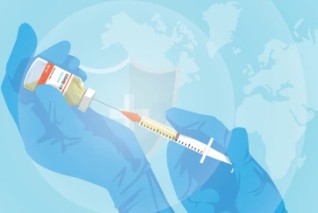New Viral Vaccine Development
 Glycosylation modification is a double-edged sword, which not only helps the host to recognize and eliminate the virus but also serves as a tool for the virus to escape the host immune system. Elucidating the mechanism of protein glycosylation modification during viral infection is helpful to explore novel molecular targets of glycosylation modification related to important pathogen infection and immune evasion, and to create new anti-infection strategies targeting abnormal glycosylation modification as well as a new way to develop vaccines.
Glycosylation modification is a double-edged sword, which not only helps the host to recognize and eliminate the virus but also serves as a tool for the virus to escape the host immune system. Elucidating the mechanism of protein glycosylation modification during viral infection is helpful to explore novel molecular targets of glycosylation modification related to important pathogen infection and immune evasion, and to create new anti-infection strategies targeting abnormal glycosylation modification as well as a new way to develop vaccines.
Vaccine development based on viral glycosylation
In the face of the threat of new viruses, it is particularly important to control the source of infection, cut off the main route of transmission as well as protect the susceptible population. Among prevention measures, an effective vaccine is a definitive solution, which can induce uninfected people to produce protective antibodies and build immune memory to fight the virus. One idea for developing a vaccine is based on viral glycosylation, which changes the glycosylation of the virus to induce the production of strongly neutralizing antibodies, making the immune response to the virus more beneficial to the body. The development of vaccines based on viral glycosylation has several directions, including,
- The absence of glycosylation can enhance the immunogenicity of viral protein and promote a better immune protective response with existing vaccinations.
- Since viral glycosides are processed by the host in biosynthesis. It is a new idea to conduct research on novel antiviral vaccines by targeting the abnormal glycosylation modification of host cells.
- The glycosylation caused by abnormal glycosyltransferase in these viruses and infected cells can also be modified through genetic recombination to delete the glycochains covering the epitopes of the antigen.
Virus vaccine development
Herpes simplex viruses (HSV)
Experimental vaccines against HSV-1 target particular viral glycoproteins. There are at least 12 different glycoproteins encoded by HSV. Among them, glycoprotein B (gB), gD, gH and gL play essential roles in the mediation of membrane fusion when HSV infects target cells. As a glycoprotein expressed on the surface of the virus, HSV gD can induce a neutralizing antibody response. Therefore, an attenuated vaccine strategy based on using HSV without glycoprotein D2 has been attempted. This vaccine can induce neutralizing antibodies to achieve better protection from HSV infection.
SARS-CoV-2
The study of glycosylation sites on S protein may promote the development of effective vaccines against SARS-CoV-2. The S protein of SARS-CoV-2 is the only antigen that is the target of neutralizing antibodies. And the S glycoprotein is highly glycosylated. It is reported that deletion of the N343 and N331 glycosylation sites of S protein could significantly reduce the ability of SARS-CoV-2 infection. While mutations of N234Q and N165Q could significantly resist neutralizing antibodies and be more sensitive, respectively.
Human immunodeficiency virus 1 (HIV-1)
It is well known that the envelope proteins of HIV are the only target for neutralizing antibodies. However, due to the heterogeneity of the HIV envelope as well as a great diversity of HIV-1 strains, there is little expected effect by using the traditional methods of vaccine preparation. At present, HIV vaccine development research aims to activate unique broadly neutralizing antibodies to act on diverse strains of HIV-1. Notably, it was found that removing the N-glycan modifications of the variable V1-V3 region of HIV-1 envelope protein can enhance the sensitivity of the virus to neutralizing antibodies. As an enveloped virus, the envelope of HIV-1 contains gp41 transmembrane protein and gp120 surface protein (one of the most highly glycosylated proteins in nature). N-glycan of HIV gp120 plays a vital role in viral infection and transmission. Similarly, the gp120 complex mutated at the glycosylation site N448E is reported to induce a stronger antiviral immunity. The above examples suggest that removing N-glycans could improve the effectiveness of HIV vaccines.
Creative Proteomics is an international contract research organization (CRO) providing a series of viral glycoproteomics services. Our array of services can be tailored to meet your needs, including,
Feel free to contact us with your inquiries about viral glycoproteomics.
Reference
- Li, Y., et al. (2021). “The Importance of Glycans of Viral and Host Proteins in Enveloped Virus Infection.” Frontiers in Immunology, 12, 1544.
* For research use only.

 Glycosylation modification is a double-edged sword, which not only helps the host to recognize and eliminate the virus but also serves as a tool for the virus to escape the host immune system. Elucidating the mechanism of protein glycosylation modification during viral infection is helpful to explore novel molecular targets of glycosylation modification related to important pathogen infection and immune evasion, and to create new anti-infection strategies targeting abnormal glycosylation modification as well as a new way to develop vaccines.
Glycosylation modification is a double-edged sword, which not only helps the host to recognize and eliminate the virus but also serves as a tool for the virus to escape the host immune system. Elucidating the mechanism of protein glycosylation modification during viral infection is helpful to explore novel molecular targets of glycosylation modification related to important pathogen infection and immune evasion, and to create new anti-infection strategies targeting abnormal glycosylation modification as well as a new way to develop vaccines.